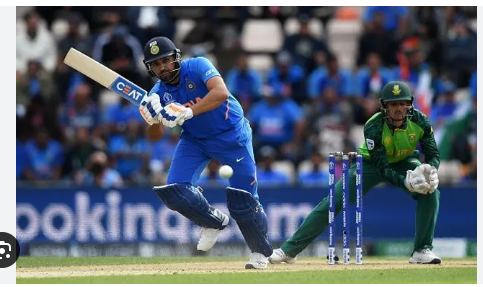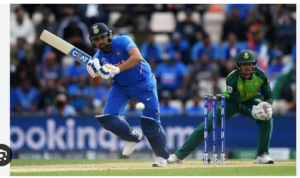
In the high-stakes semi-final of the ICC Champions Trophy 2025 held at the Dubai International Cricket Stadium, India faced Australia in a match that would determine who advanced to the final. Australia, having won the toss, elected to bat first and set a target of 265 runs for India. The Indian innings, however, began with moments of fortune that played a pivotal role in shaping the outcome of the match.
Australia’s Innings: Setting the Target
Opting to bat, Australia aimed to post a competitive total on a pitch that had shown variable behavior in previous matches. Their innings was anchored by captain Steve Smith, who played a composed knock of 73 runs. Smith’s innings was characterized by his typical resilience and shot selection, providing stability after the early loss of opener Cooper Connolly. Alongside him, wicketkeeper-batsman Alex Carey contributed a valuable 61 runs, accelerating the scoring during the middle overs. Despite these contributions, Australia’s innings faced disruptions as key players like Smith and Glenn Maxwell departed in quick succession. The Indian bowlers, notably Mohammed Shami and Varun Chakaravarthy, applied consistent pressure. Shami’s figures of 3/48 were instrumental in restricting Australia to a total of 264 runs, as they were bowled out in 49.3 overs.
India’s Chase: Early Reprieves for Rohit Sharma

Chasing a target of 265 runs in a semi-final is always a pressure-laden task, and India’s start was marked by moments that could have drastically altered the course of the match. Indian captain Rohit Sharma, known for his aggressive style of play, was granted two significant reprieves early in his innings.
The first chance came when Rohit was on 13 runs. Facing Nathan Ellis, Rohit attempted an expansive shot but failed to connect cleanly. The ball soared towards Cooper Connolly, who was positioned in the field. Connolly moved to his left and attempted a catch, but the ball slipped through his fingers, granting Rohit a lifeline. This missed opportunity was a significant moment, as dismissing the Indian captain early could have tilted the momentum in Australia’s favor.
The second chance occurred shortly after, with Rohit on 14 runs. This time, he misjudged a delivery and offered a catch to Marnus Labuschagne. Labuschagne, despite his agility, failed to secure the catch, allowing Rohit another reprieve. Such consecutive missed opportunities are rare at this level and underscored the pressure of a semi-final setting.
Impact of the Dropped Catches
Cricket matches, especially at the international level, often hinge on pivotal moments. The two dropped catches of Rohit Sharma were such moments in this semi-final. Had either chance been taken, India would have been under considerable pressure, potentially exposing their middle order earlier than anticipated. Rohit’s presence at the crease not only provides stability but also allows other batsmen to play around him with confidence.
Historically, Rohit has been a player who capitalizes on such lifelines, often converting them into substantial scores. His ability to anchor the innings while maintaining a healthy strike rate makes him a crucial asset in run chases. Australia’s failure to dismiss him early undoubtedly had a psychological impact, as bowlers had to contend with a batsman who was given not one but two chances to make amends.
Australia’s Fielding Woes
Fielding, often referred to as the “third discipline” in cricket, plays a crucial role in determining the outcome of matches. Australia, traditionally known for their sharp fielding standards, seemed to falter under pressure in this crucial encounter. The dropped catches not only provided India with scoring opportunities but also affected the morale of the Australian team. Each missed chance added to the mounting pressure, leading to further lapses in the field.
India’s Response: Building the Innings

Capitalizing on the early reprieves, Rohit Sharma began to anchor the Indian innings. His partnership with fellow opener Shubman Gill laid a solid foundation for the chase. The duo rotated the strike effectively, ensuring that the scoreboard kept ticking. Rohit’s experience combined with Gill’s flair made it challenging for the Australian bowlers to build pressure.
As the innings progressed, the Indian batsmen showcased their prowess against both pace and spin. The middle order, comprising Virat Kohli and Shreyas Iyer, built on the foundation laid by the openers. Their contributions ensured that India remained on course, keeping the required run rate in check.
Australia’s Bowling Efforts

Despite the setbacks in the field, the Australian bowlers continued to toil, seeking breakthroughs to bring their team back into the contest. Nathan Ellis and Ben Dwarshuis, sharing the new ball, aimed to exploit any early movement off the pitch. Ellis, in particular, was probing with his lines and lengths, creating opportunities that, unfortunately for Australia, were not capitalized upon.
Spinner Adam Zampa was introduced early into the attack, aiming to exploit any turn on offer. Zampa has had success against key Indian batsmen in the past, notably Virat Kohli, whom he has dismissed multiple times in ODIs. However, on this occasion, the Indian batsmen negotiated his overs with caution, ensuring they did not provide him with wickets that could shift the momentum.
Turning Point: Rohit’s Resilience
The essence of high-pressure matches lies in pivotal moments that can alter the course of the game. Rohit Sharma’s resilience after the two dropped catches exemplified this. Recognizing the lifelines granted to him, Rohit adjusted his approach, balancing aggression with caution. His shot selection became more judicious,








